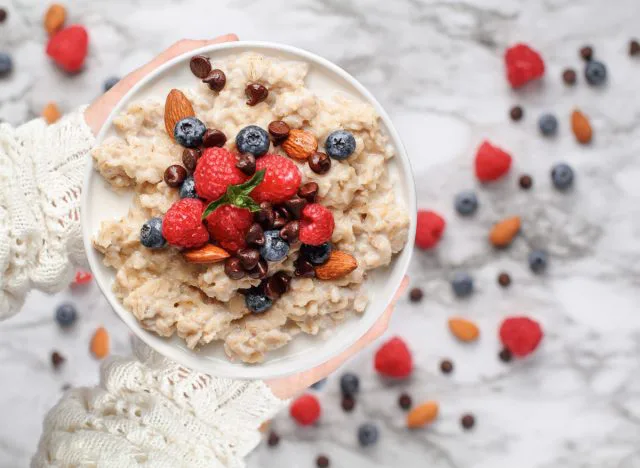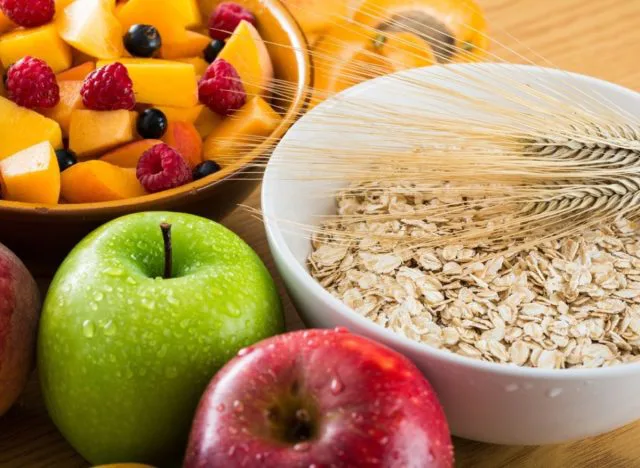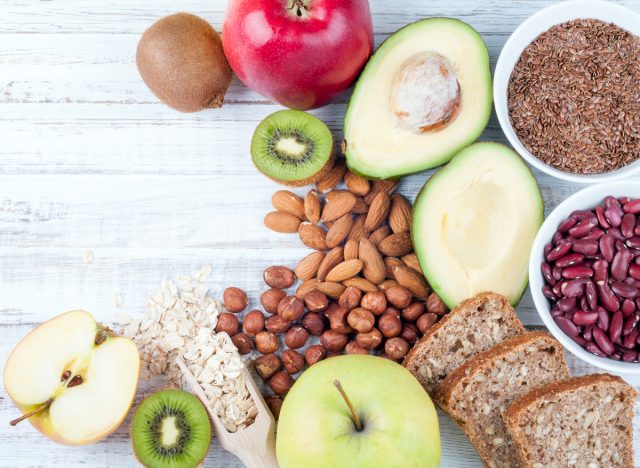Eating more fiber can help you lose weight, lower your cholesterol, and may even help you live longer.
Fiber is a type of carbohydrate, but unlike other carbs, it doesn’t break down completely during digestion.
Fiber is found in plant-based foods and can be divided into two types: soluble and insoluble.
Soluble fiber dissolves in water and forms a gel-like substance that slows digestion; these characteristics also allow soluble fiber to help manage cholesterol and control blood sugar.
Insoluble fiber adds bulk to stool and helps things move through your digestive tract more easily. Most foods contain a combination of both types of fiber, but the ratio of each type depends on the food.
1. Foods that contain fiber help you feel fuller

Foods rich in fiber help you feel fuller.
One of the great benefits of a high-fiber diet is that fiber-rich foods help you feel fuller, so you eat less.
According to Harvard Health, soluble fiber draws water from the intestines and forms a gel-like substance, slowing down the rate at which it is completely digested. According to the U.S. National Library of Medicine, these types of fibers delay gastric emptying, meaning food takes longer to travel from the stomach to the small intestine, thus slowing hunger.
2. Fiber Improves Gut Microbiota

Fiber helps improve microflora, supporting a healthy gut.
Maintaining a healthy gut is essential for disease prevention and overall health. A high-fiber diet plays an important role in improving gut health. Fiber is fermented by the gut microbiota, leading to the production of beneficial microbial metabolites. These metabolites act as an energy source for intestinal cells and play an important role in regulating metabolism, the immune system, and brain health, and may even prevent inflammation.
3. Fiber is effective in preventing constipation
If you often face the discomfort of constipation, it may be a sign that you need to increase your fiber intake.
Fiber-rich foods help you have regular bowel movements and prevent constipation because they can soften stools, making them easier to pass.
A high-fiber diet not only helps regulate digestion in the short term, but also helps prevent disorders related to the digestive tract.
4. Fiber Can Improve Your Metabolism
Among other benefits, getting enough fiber each day is also beneficial for your metabolism. A 2017 study published in the American Journal of Clinical Nutrition looked at the differences between eating refined grains (grains that are highly processed and low in fiber) and whole grains (grains in their more natural form that are higher in fiber).
At the end of the study, the group that consumed whole grains had a higher resting metabolic rate, which the researchers believe may contribute to fiber’s effects on weight loss and weight management.
5. Control your weight with a high-fiber diet

Foods rich in fiber are beneficial for metabolism and weight control.
If you’re on a weight loss journey or looking to control your weight, adding more fiber-rich foods to your diet is a great way to achieve that goal.
According to the American Journal of Nutrition, fiber intake is associated with greater weight loss as well as better adherence to diet plans that involve calorie restriction.
6. Fiber Helps Lower Cholesterol

Soluble fiber can help lower cholesterol levels
A high fiber intake has also been linked to heart health—specifically blood cholesterol levels. Fiber, especially soluble fiber, can help reduce the amount of cholesterol your blood absorbs, which can help lower LDL cholesterol (the bad kind). Even just 5 to 10 grams of soluble fiber per day can lower cholesterol levels, according to the Mayo Clinic.
7. Foods high in fiber can help reduce inflammation
Research shows that a high-fiber diet can also help reduce chronic inflammation—a serious condition that can contribute to many common diseases, including Alzheimer’s, heart disease, arthritis, and type 2 diabetes.
According to a report published in the American Journal of Clinical Nutrition, a high-fiber diet has a protective effect against what’s called C-reactive protein, a common marker of inflammation found in the body. That means that the higher the C-reactive protein, the more inflammation there is. Therefore, these researchers used these findings to support their recommendation of using fiber as a dietary approach to controlling inflammation.
8. Fiber Helps Manage Blood Sugar

Fiber helps control blood sugar levels.
For those watching their blood sugar, eating more fiber can also be a helpful solution. In fact, according to the Centers for Disease Control and Prevention (CDC), fiber is considered a “diabetes-management carb” because of its ability to help control blood sugar.
Normally, the body breaks down carbs into glucose, which then enters the bloodstream. This can cause blood sugar levels to rise. However, fiber (also a carb) cannot be broken down into glucose and instead just moves through the body. Therefore, fiber-rich foods help prevent blood sugar spikes after eating high-carb meals.
9. Reduce Your Risk of Heart Disease with a High-Fiber Diet
Many studies have shown that eating a high-fiber diet can help reduce your risk of cardiovascular disease (CVD) and other heart-related problems.
For example, a 2022 study published in BMC Public Health found that eating more fiber can reduce your risk of cardiovascular disease, especially in participants aged 20-39 and 40-59.
10. Fiber is linked to a longer lifespan
This isn’t surprising when you consider all the benefits a high-fiber diet has on overall health. This has been proven by specific research.
A study published in the Archives of Internal Medicine found that eating fiber can help reduce your risk of premature death, and a report published in the journal Nutrients concluded that fiber is linked to a longer lifespan and a lower risk of chronic disease. Therefore, experts recommend that you eat more fiber because of its ability to reduce the risk of cardiovascular disease and death from cancer.





